Check out our range of stock.
Didn't find what you like?
Send us a message
Found something out of stock?
Send us a message


Aquatic Plant Explosion APE is a sustainability project created within the Nano Tanks Australia Brand. It is our hope that with APE we can provide a sustainable, quality products for our customers.
Nano Tanks Australia strives to be an empowering company and the APE Initiative is no different.
In future APE will have it's own YouTube channel and it will be a seperate entity from Nano Tanks Australia. It is the hope that APE will provide essential bunch plants to NTA customers.
Thank you for looking. If there is something you are looking for and it is not present here please let me know and we will try to get it in.
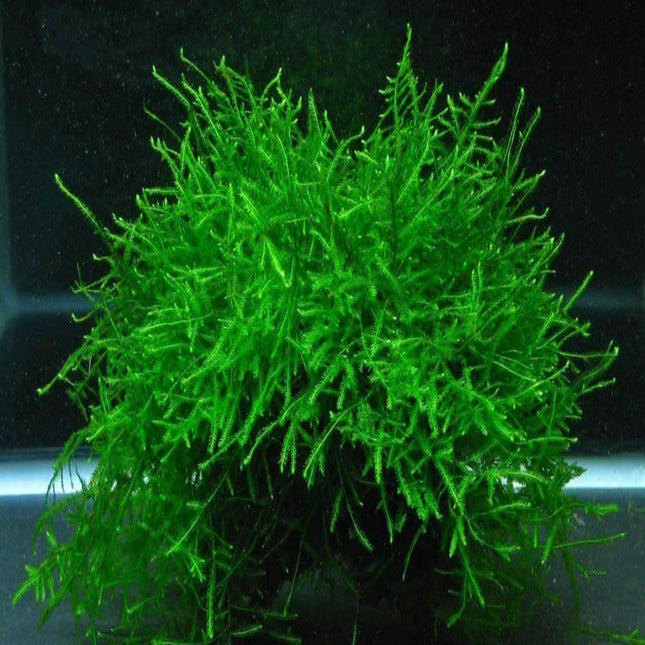
Java moss is one of the easiest to grow, and hardy, aquarium plants around. It belongs to the Hypnaceae family and is native to Southeast Asia. It is very common in moist tropical climates and grows on rocks, river banks and tree trunks. Due to its low requirements regarding water quality and lighting, it is perhaps the most common moss amongst freshwater aquarists and is widely available both in shops and online. It is commonly used for aquascaping and can produce beautiful results. It also has many other benefits such as providing protection for eggs and fry, improving tank health and providing food for breeding fish. Category Rating Care Level: Very easy Growth Rate: Low to Bright Temperature: 15 to 30C (59-86F) PH: 5.0 to 8.0 Reference: https://www.fishkeepingworld.com/java-moss/ Portion Size: 5x5cm when laid out flat which equates to 5 grams weight (without excess water) We send Java Moss orders via Unregistered post
$5.00
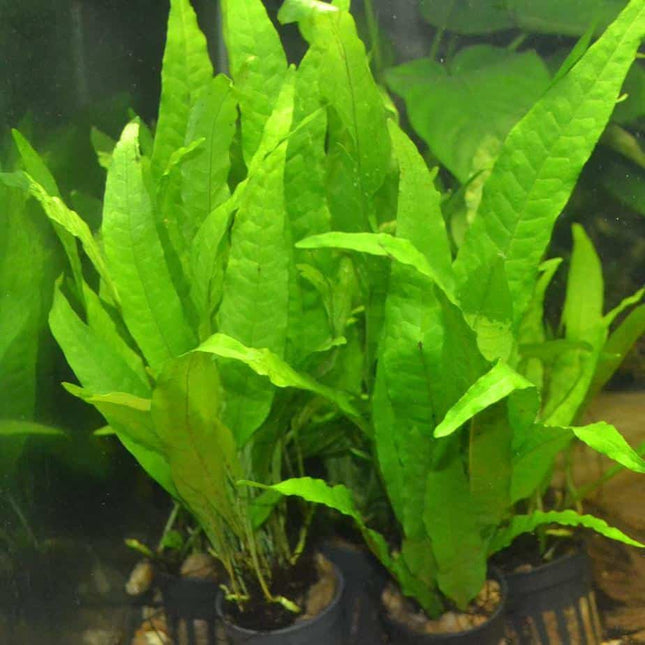
JAVA FERN: THE BEST PLANT FOR YOUR PLANTED AQUARIUM Java ferns (microsorum pteropus) are perfect for aquariums. They're small, easy to grow, and don't need a lot of light to survive. Ask us for varieties we have available. For example, there are needle leaf varieties that require bright lights, as well as more traditional 'jungle' leaves such as the Narrow Leaf, Lance Leaf, and Windelov – their many varieties to suit your needs inside your aquarium. Your fish will appreciate the natural hiding spots provided by Java Fern so they can get away from time to time and feel safe and secure when they want it. Identification If you want a true aquatic plant that can grow when submerged in water or even partially out, then the Java fern is perfect for your tank. Our diverse line of beautiful and delicate-looking Java plants are perfect for people who prefer an aesthetic look inside their home aqua garden without crazy maintenance requirements. When you require a go-to plant that looks great in almost any aquascapes, go with Java Ferns (from Nano Tanks Australia with our aquascaping expertise, of course!). The narrow-leaf Java fern generally boasts long, skinny leaves, with the plant growing to a height of 10-12 inches (25-30 cm). Java Fern is perfect for those who have limited space or are trying to create an artificial jungle feel in their aquarium. The plants need bright light, but indirect (not right under the light), so they can grow properly. Keep in mind the sun has a much more potent energy than your tiny aquarium lights, so aquarium keepers can tend to underestimate the wattage and spectrum required. Saying that, in nature Aquatic Java Fern tends to never receive direct light in the jungle river. So although the Java Fern will be fine with low light in the tank, its growth rate will not impress you. What You Should Know about Java Fern It's probably better than any other plant that would grow inside an aquatic environment for this reason - its fronds are big enough for fish to swim through them without getting stuck between leaves. A striking addition to any freshwater planted aquarium, perfect if you have cichlids or South American fish. Fortunately, it's also relatively easy for plant-eating goldfish and other tank mates to leave it alone because of its tough rhizomes! Java Fern does well in water with pH levels between 6-7.5, as long as the alkalinity stays below eight dKH (aka carbonate hardness). If you see black spots (or brown spots) in your plant's leaves, don't worry - they do that. Java ferns have veins running through them, and sometimes new bumps will pop up on the leaf from which a new shoot emerges. Planting and Replanting Java Fern in the Aquarium Java ferns grow beautifully with other live plants since they are so robust, but they also make a great centrepiece for the aquarium when planted alone. Alternatively, you can attach java fern to aquarium decorations (like rock or driftwood) to create an elegant look that will not overwhelm your fish tank with too much greenery! Java Fern is a hardy plant that can live in any tank size, making it perfect for apartment dwellers who don't have room for large aquariums! If the water stays clean (and you're not adding liquid fertiliser), this resilient Fern's growth will remain consistent without any problems. The Fern prefers water with soft-to-moderate temperatures of 22 degrees Celsius. Data at a glance for Java Fern Family: Polypodiaceae Care Level: Easy Growth Rate: Low to Moderate Maximum Size: 30cm Minimum Tank Size: 20 Litres (tall tank) Water Conditions: 20-28°C pH 6.0-7.5 KH 3-8 Lighting: Low to Moderate (Depending on the desired rate of growth) Propagation: Adventitious Plantlet/Rhizome Division Placement: Mid to Background
$15.00
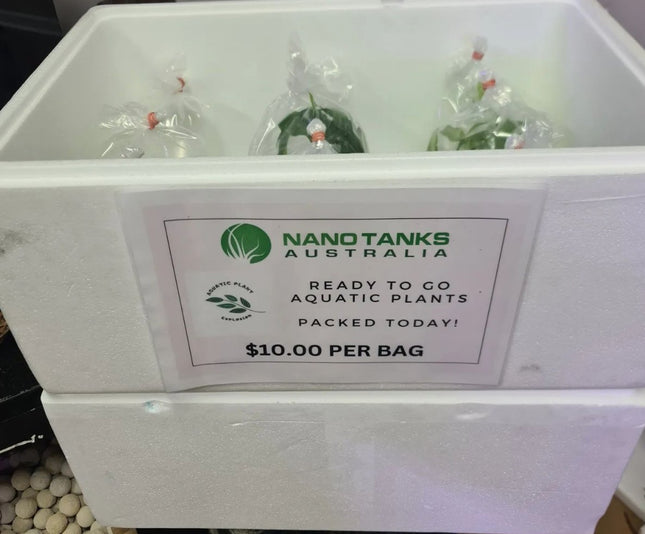
Assorted aquatic plants are a group of plants that are specifically adapted to grow in aquatic environments. These plants can be found in a variety of aquatic ecosystems, including freshwater ponds, streams, rivers, and lakes. Aquatic plants play a crucial role in maintaining the health and balance of aquatic ecosystems by providing oxygen to the water, absorbing excess nutrients, and providing habitat and food for aquatic animals. In the aquarium hobby, aquatic plants are often used to add visual interest and to help maintain good water quality by reducing the amount of harmful nitrogen compounds in the water. Assorted aquatic plants are available in a wide variety of shapes, sizes, and colors. Some of the most common types of aquatic plants include hornwort, Java moss, Anubias, and Cryptocoryne. Each type of plant has its own unique characteristics and requirements for growth, so it's important to research the specific needs of the plants you plan to keep in your aquarium. When keeping assorted aquatic plants in an aquarium, it's important to provide them with the right conditions, including the right type of substrate, adequate light, and the right temperature and water chemistry. In addition, it's important to keep the aquarium well-maintained and to provide regular water changes to ensure that the plants receive the nutrients they need to grow and thrive. Overall, assorted aquatic plants are an important and attractive addition to any aquarium, and they can provide a beautiful and natural underwater environment for your fish and other aquatic animals. Whether you are a seasoned aquarium hobbyist or a beginner, there is sure to be a type of aquatic plant that is right for your aquarium. These plants are packed fresh daily and a great addition for any tank!
$10.00
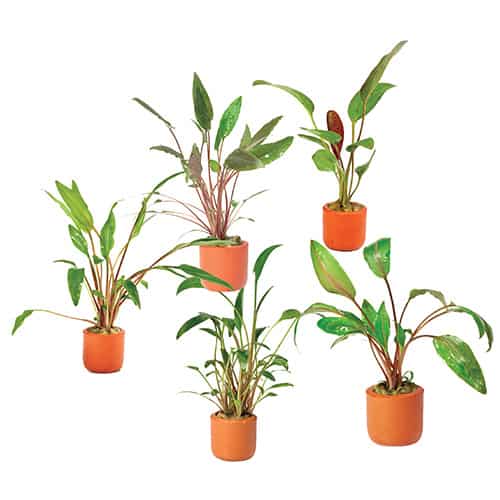
The following are on offer in an assorted basis:Mi OyaLuteaHybridPetchiiWalkeriFamily: AraceaeOrigin: Sri LankapH: 5.5 – 8Temperature: 20 – 30° CHeight: 5 cm – 40 cmLighting: Low
$10.00
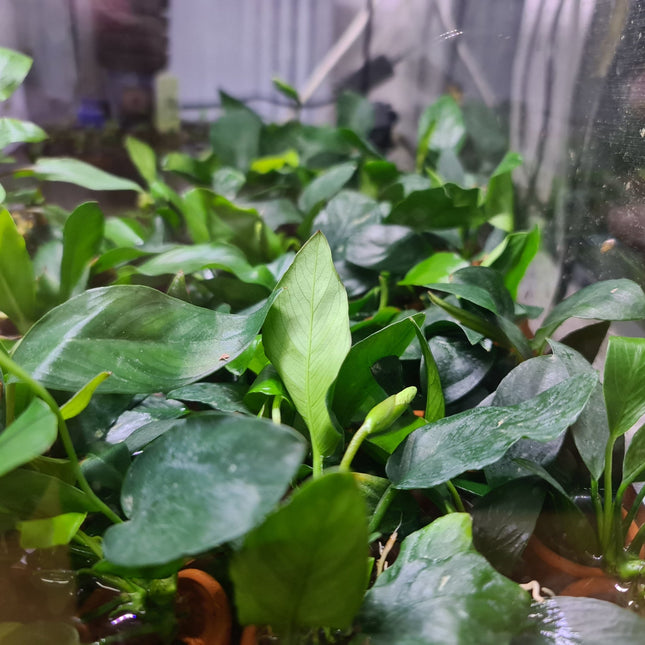
Sold as individual pieces. The image is an example of the quality you are getting Most of what is being sold are: Anubias Barteri Anubias Hastifolia Anubias Nana This is random and there is no choice on which plant you will get unless you are in the shop picking it out yourself
$20.00

The Amazon Swords or Echinodorus Species are a very nice plant that works well with bright light. These plants are used as a background plant and works well when grown emersed or submersed. If you are looking for an undemanding plant then consider these plants. Minimum Tank Size: 10 Litres Care Level: Easy Water Conditions: 6.5-7.5 (Soft to Moderately Hard) Temperature: 22–27 °C (72–82 °F) Maximum Size: 24 inches (60 cm)
$20.00 - $45.00
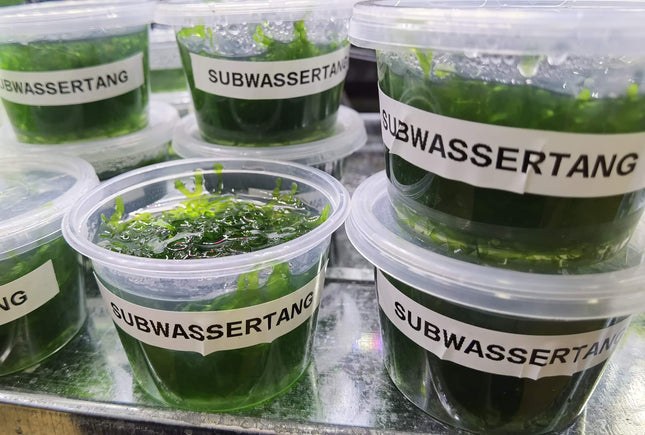
Susswassertang is a type of aquatic plant that is native to Europe and parts of Asia. It is a unique and interesting species that is highly sought after by aquarium hobbyists due to its attractive appearance and ease of care. Susswassertang is a type of liverwort that grows in dense, matted clumps. It has a dark green coloration and a distinctive, textured surface that can resemble a tangled mass of hair or a miniature forest. The plant is non-vascular, which means that it does not have any true roots or leaves, and it absorbs nutrients and gases directly from the water. One of the benefits of Susswassertang is that it is an extremely easy plant to care for. It does not require any special lighting, fertilization, or CO2 supplementation, and it can thrive in a wide range of water conditions. This makes it an ideal plant for beginners or anyone who is looking for a low-maintenance option for their aquarium. Susswassertang is also a versatile plant that can be used in a variety of different aquascapes. It can be attached to rocks, driftwood, or other decorations to create natural-looking features, or it can be allowed to float freely in the water to create a more organic and untamed look. Overall, Susswassertang is an excellent choice for anyone looking for an attractive, easy-to-care-for, and versatile plant for their aquarium. Its unique appearance and hardy nature make it a great option for aquarists of all levels of experience, and its ability to grow in a variety of water conditions makes it a great choice for a wide range of different aquarium setups. What You will be getting You will be getting a 50c portion
$6.00
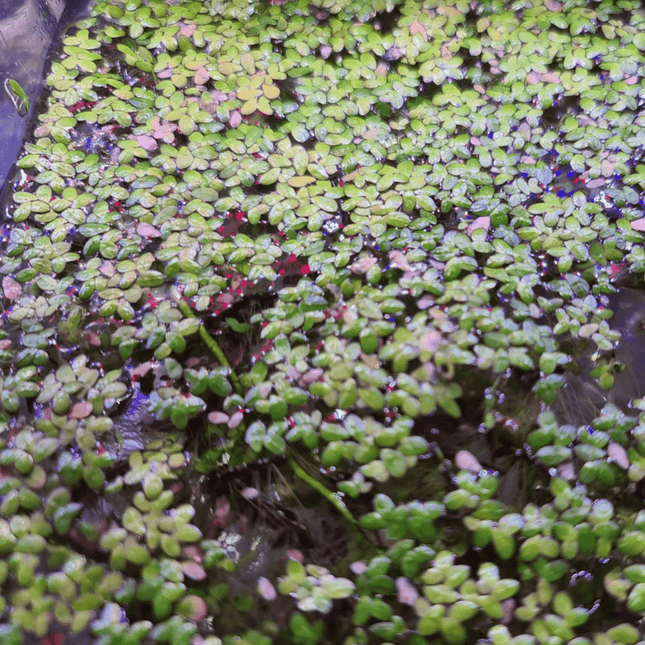
What is Duckweed (Lemna disperma)? Overview Duckweed Lemna disperma is an oval or sometimes round herb that is endemic to Austalia. It has an average size of 1-4 mm long with red and green body coloration that grows 3 to 5 veins. It is known to be one of Earth's most miniature flowering plants. Lemna diaspora tends to form a thick green mat that slowly drifts on the water surface. The plants primarily reproduce vegetatively, with two daughter plants budging off from the adult plant. This type of growth allows new water to be colonized very quickly. Duckweeds sexually multiply themselves by flowering and producing seeds under appropriate water conditions. Duckweeds spread quickly and produce a lot of new offshoots. Therefore, dense populations are beneficial to aquatic species. Herbivore fishes would benefit the most Scientists have recently recognized duckweeds' rapid growth rate, and the plants are now used for bioremediation of waterways with high levels of nitrogen and phosphorus that come from agricultural runoff.
$5.00
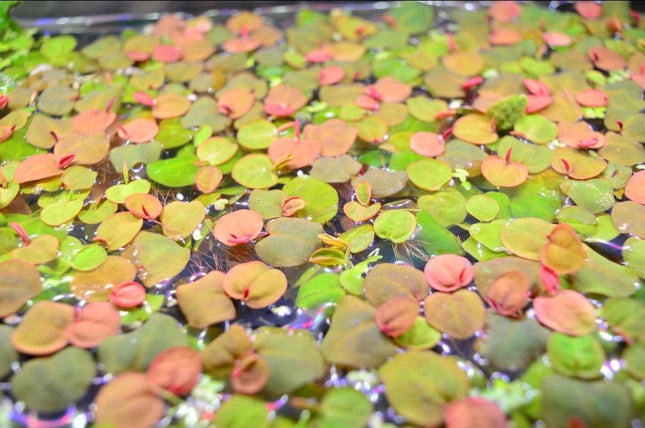
Red Root Floaters are a type of aquatic plant that are commonly found in freshwater aquariums. They are named after their bright red roots, which are visible above the water line and give the plant its distinctive appearance. The leaves of red root floaters are usually green and oval in shape, and they float on the surface of the water. Red root floaters are popular among aquarium hobbyists because they are easy to care for and can help to improve water quality by removing excess nutrients from the water. They are also often kept as decorative plants, as they provide a striking contrast to the green leaves of other aquatic plants and can help to create a natural-looking underwater environment in an aquarium.
$10.00
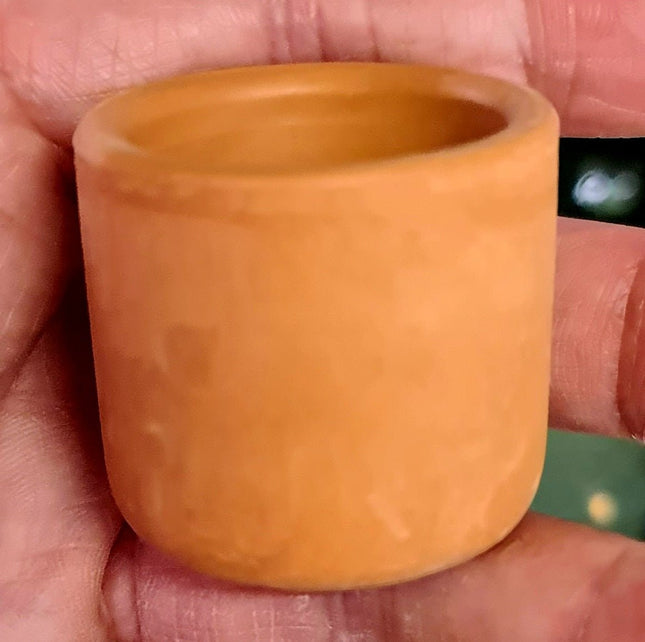
This terracotta pot is 3 cm tall and has a classic, round shape. It is made of terracotta, a type of earthenware clay, and has a light orange hue. The pot is perfect for small plants or succulents, and can easily be used as a decorative piece in any home or garden. The pot is unglazed, making it ideal for plants that require more water, as the clay is porous and allows for better drainage. The terracotta pot is sure to add a rustic charm to any space.
$2.20 - $2.50
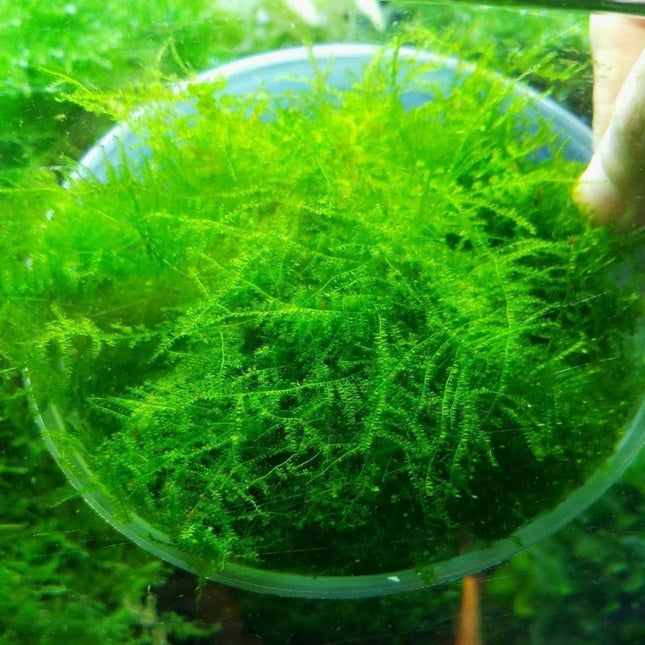
Christmas Moss is a popular and versatile aquarium plant that is native to Southeast Asia. Its distinctive appearance is characterised by its feathery, branching fronds that resemble a miniature Christmas tree. Christmas Moss is a great option for nano tanks and can be used to create lush, natural-looking aquascapes that are perfect for shrimp and other small aquatic creatures. One of the benefits of Christmas Moss is that it is an easy plant to care for, making it a great option for beginner and experienced aquarists alike. It is a hardy plant that can thrive in a wide range of water conditions and lighting levels, and it is not particularly demanding when it comes to nutrient requirements. Another advantage of Christmas Moss is that it is a great plant for shrimp tanks. It provides plenty of hiding places and resting spots for shrimp, which can help them feel more comfortable and secure in their environment. The dense, branching structure of the moss also helps to filter and clean the water in the tank, which can be beneficial for the health of the shrimp and other aquatic creatures. In terms of aesthetics, Christmas Moss is a very attractive plant that can add a natural, organic look to any aquarium. Its feathery fronds can be used to create a variety of different aquascapes, including moss walls, carpets, and even trees. Because it is such a versatile plant, it can be used to create a wide range of different looks and styles, depending on the preferences of the aquarist. Overall, Christmas Moss is a great choice for anyone looking for an easy, attractive, and versatile plant to add to their aquarium. Its hardy nature, low maintenance requirements, and compatibility with shrimp make it a great option for nano tanks and any other aquarium where space is at a premium. Portion Size: 5x5cm when laid out flat which equates to 2-2.5 grams weight (without excess water)
$10.00
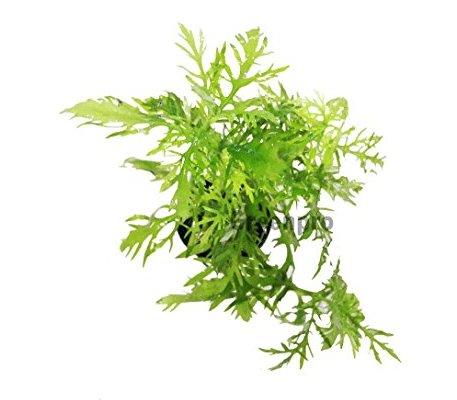
It can be kept as a mid-ground or background plant in tanks of a minimum 10 gallons. The water should be soft to moderately hard and pH should be 6.5-7.5, but it has been noticed this plant will thrive in any conditions, though fertilizers should still be added. The water wisteria does best in water temperatures of 75-82 degrees Fahrenheit. Planting your Water WisteriaThe best substrate for this plant is a specialty plant substrate very rich in nutrients. It can still grow in small grain gravel or sand substrate, as long as you keep fertilizing it with fertilizing tabs, but be careful to anchor the wisteria if you plant it in sand until the roots are well established in the substrate to avoid accidental uprooting. The water wisteria makes a good mid- to background aquarium plant, but can also be grown as a carpet. For this, you have to plant it on its side and make sure the roots are developed along the stem This way, leaves will only grow on one side and extend along the substrate to create a carpet effect. For a more striking effect, plant it between rocks or pieces of wood or next to other contrasting plants. Care for your Water WisteriaThe water wisteria is very easy to care for, as it thrives in many conditions even without CO2 supplementation. For the best look and sturdy leaves, make sure you provide a nutrient rich substrate or at least constant fertilizing with tabs. Fertilizing is very important, as the plant needs nitrate, phosphate, and, most importantly, iron to have a healthy development. Iron deficiency can easily be noticed if the leaves turn pale and yellowish. Remove any dead or brown sections to prevent infections from spreading throughout the plant; this also allows it to use its energy and nutrients only for the healthy leaves and stems. Occasional trimming may be needed to make sure light and nutrients reach all the stems and roots. You can always replant the stems you trimmed if you want lush vegetation. It will grow well under moderate light, but strong light will help accelerate the wisteria’s growth rate and maintain the most intense colors. ReproductionPropagation is conducted through stem or leaf cutting near the base of the mother plant. Plant cuttings will soon grow their own roots and develop into a new plant; if you keep cutting and replanting, newly developed shoots from each plant will form a bushy effect and you can even leave the plant to propagate by its own shoots to allow it to cover a larger surface. We sell wisteria in terracotta pots for easy planting Reference: https://www.theaquariumguide.com/articles/water-wisteria-guideImage: https://images.app.goo.gl/PeWXMJhdYdDJ5NgN7
$10.00 $5.00
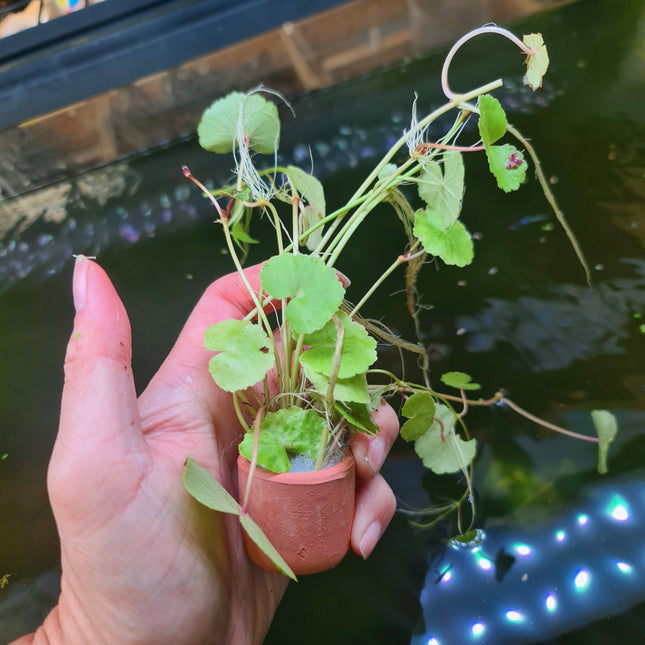
Hydrocotyle Leucocephala originates from the wet marshlands of South America , and also holds the name Brazilian Pennywort. It grows well very well submerged and loves temperatures to be between 18-24C. A fast-growing vine-like aquarium plant with kidney-shaped leaves, Hydrocotyle Leucocephala survives in tanks where other plants fail! It thrives in tanks with or without Co2 added and requires only medium light. In high lights it can become rampant, lower lights make it easier to control. Hydrocotyle Leucocephala looks beautiful intertwined with driftwood. Its delicate leaves are a favourite climbing place for shrimps. Hydrocotyle Leucocephala works particulary well in tanks with Anubias as the two kinds of aquarium plants require similar conditions. Selling in a terracotta pot with 3 to 5 plant let's. These plants should be planted in aqua soil or gravel. Best kept in heights of 30cm tanks We grow this plants in our display tanks.
$10.00
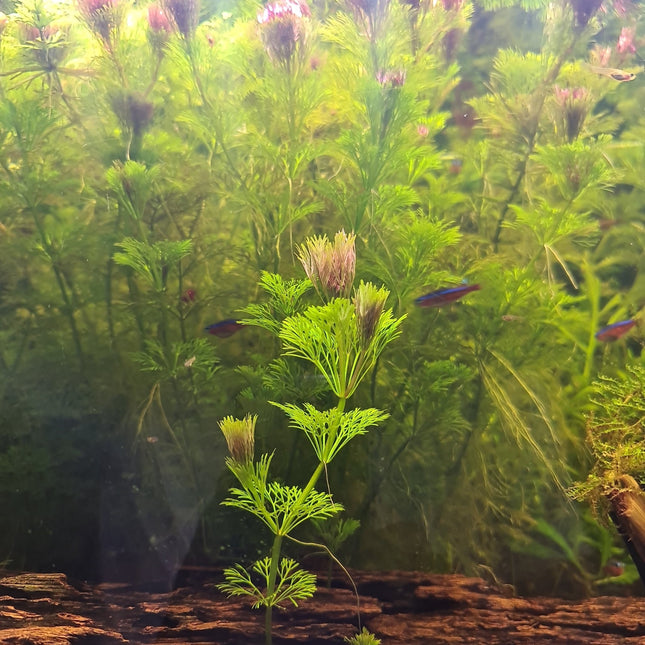
Ambulia is a nice bunched plants that is great for tanks with livebearers or egg scatterers. Ambuilia needs high light to be successful. However when it is established it will grow fast. Please note that the way we sell these are different from other stores. They are best sold loose and best planted loosely.. They are a great source for infusoria and other small invertebrates. Ideally these are floated at the top of the aquarium We grow this in our display tanks Difficulty Easy to keep. Best to keep with species of fish that do not consume plant material. Water Conditions Temperature: 22 - 28°C pH: 5.5 – 8.0 Water Hardness: 70 – 300ppm
$8.00
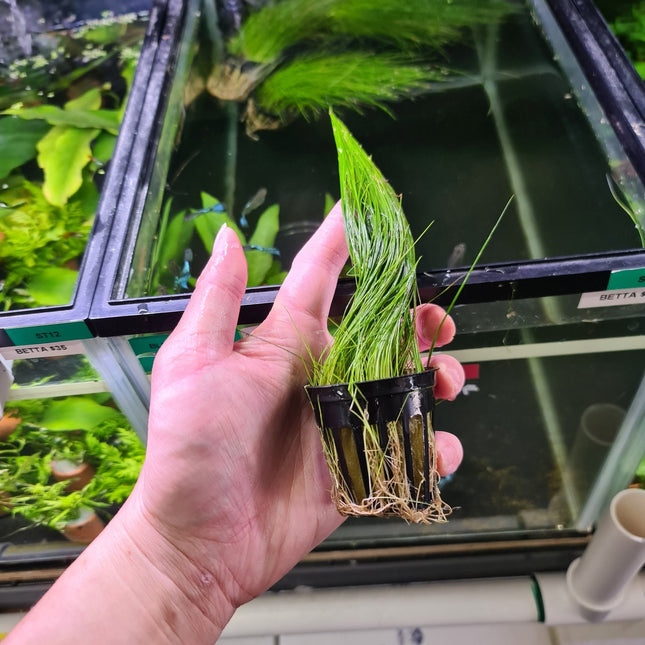
This Hairgrass on Pot brings a unique, vibrant look to any home decor! Its lush green foliage provides a natural beauty to any setting. The pot allows for easy transfer of the plant to any desired location. With proper care, this Hairgrass will last for years of enjoyment.
$10.00
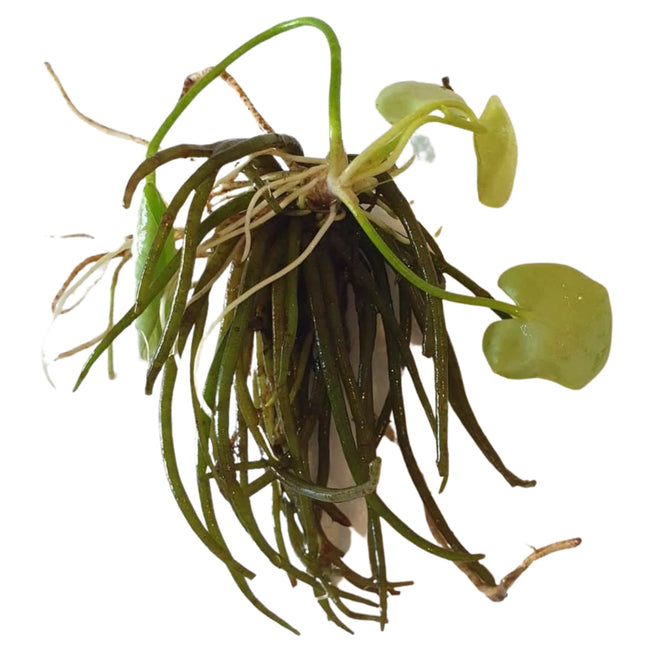
Banana Lily Nymphoides Aquatica – An Atypical Aquarium Plant for Beginners Nymphoides Aquatica is a lovely aquatic plant that can be used in any pond or planted aquarium. It natively grows along the southeastern United States from Texas to Maryland and has been known various names such as Banana Lily due to its banana-shaped roots. Banana Lily Factsheet Scientific Name: Nymphoides Aquatica Native To South/Southeastern United States Skill Level: Easy Placement: Foreground - Midground CO2 Requirements: none Warning: Banana plants do best if rested on top of the substrate or buried to about 1/4 inch so the plant can send roots down into the substrate. If buried too deeply, the plant may rot and eventually die. Also Snails and plecos are known to eat banana plants! How To Plant Your Banana Plant Introducing a new banana lily to your aquarium is very easy. First, make sure that you have at least two inches of substrate in the tank, such as gravel or sand, and select an area with good lighting conditions and gentle water flow. To keep your plant in place, make sure to rest the plant's tubers on top of the substrate gently. You can also bury them a quarter-inch into the ground if you want it firmly rooted there immediately. Don't worry if none of these methods work for whatever reason, and they still refuse to stay put! They will eventually send down long roots that attach themselves with help from gravity, so this is just something temporary until then - patience is critical when dealing with these plants! At up to 15cm tall, this species can be used for foreground plants, midground planting, or even as background plants for small tanks like 20 litre nano tanks. How To Care For a Banana Lily Banana lilies have a moderate growth rate, and they won't get out of control, making them perfect for beginners and those with limited space. They prefer temperatures between 20 to 28°C and can survive in low-light conditions. (The more light you give it, the faster it'll grow.) These easygoing fellows don't even require CO2. They are hardy little plants! If you want your banana lily to thrive over time, though, be sure to provide an all-in-one liquid fertiliser every three or four months. Not only will this keep their roots healthy but also stimulate cell division within shorter periods so new leaves form much quicker too. At first, the long shoots will grow toward the surface of your tank and start shooting up heart-shaped leaves, which look like lily pads in some cases with small white five petalled flowers. These plants are great for helping filter out excess nutrients from your water while adding an aesthetic beauty that most other aquatic plants can't offer. Just be careful not to let these floating leaves block all of the light from reaching other plants as well - make sure you prune them if needed. There are many ways that the banana lily may perish after planting. One of these possibilities is if its tubers melt away and disappear. There have been a few theories as to why this happens, but no solid explanation. Perhaps the plant doesn't need the lily anymore because it's getting enough nutrients from the roots. Even when plants start looking unhealthy, they can still grow strong with time. How To Grow More Banana Plants Have you ever wondered how to grow banana plants? It's easy! Cut off one of the leaves and let it float around in your tank. Eventually, new roots will appear with some small leaves, which can then be planted back into the substrate. Since banana is in the name, is the Banana Lily at all edible? Banana lily has no known direct food value to wildlife. However, even though it can't be consumed by animals directly, submerged portions of all aquatic plants provide habitats for many micro and macro invertebrates, which are used as food for the animal world. Inevitably when these plants die, their decomposition provides much-needed sustenance that feeds a variety of other underwater denizens. In the home aquarium, the Banana Lily is purely for aesthetics, water quality, and somewhere for smaller fish and shrimp to hide. Variations of Delivery Usually what you get on this picture is what you will receive. Sometimes however you will be getting a leaf. If you do the banana lily will sprout at the base of the leaf
$10.00

This culture form of the stalk plant Bacopa Monnieri is more compact and, under good light conditions, almost a creeping plant. By pinching off all vertical growing shoots, the plant can maintain a low and close growth, since it willingly creates a large number of side shoots. Furthermore, the plant grows well in the shadow of other plants. Very suitable as a bit higher carpet – or bushy plant in the middle or front of the aquarium. The plant becomes more vertical growing and less compact without CO2 additive and decreased light conditions.
$5.00
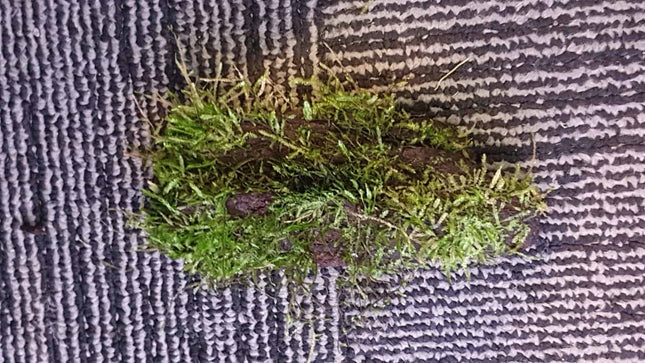
Java Moss on Driftwood (Nano Size) This driftwood fits a 10L tanks comfortably and would look great to tanks up to 60L. It also houses life Java Moss and this means that you can put it into the tank directly with no issues. Please note that we do have these driftwood in various sizes and some discrepancies is advised.
$12.95
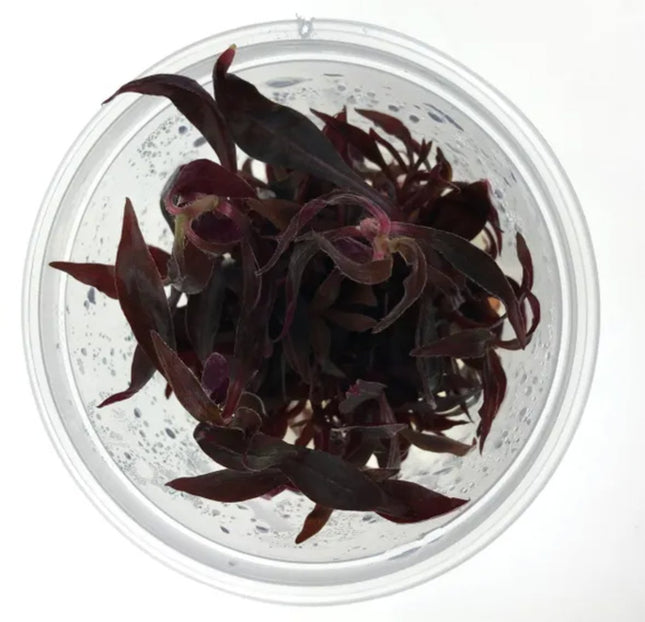
Aquarium plant from tissue culture in closed cup. This miniature version of the well-known Alternanthera is characterised by compact growth and a slower growth rate. It is particularly suitable for small aquariums or as a foreground plant in larger aqua scapes. By careful trimming can you create a dense, red-violet carpet approximately 5 to 10 cm high. High light intensity and addition of CO2 improves the plants growth and overall appearance. Plant information Type: Stem Origin: Cultivar Growth rate: Medium Height: 5 - 10+ Light demand: Medium CO2 : Medium Reference: https://tropica.com/en/plants/plantdetails/Alternantherareineckii'Mini'(023CTC)/4439 Please note that Pisces has omitted the 'mini' label in their recent labels. However we are assured these are still the mini variety
$14.95
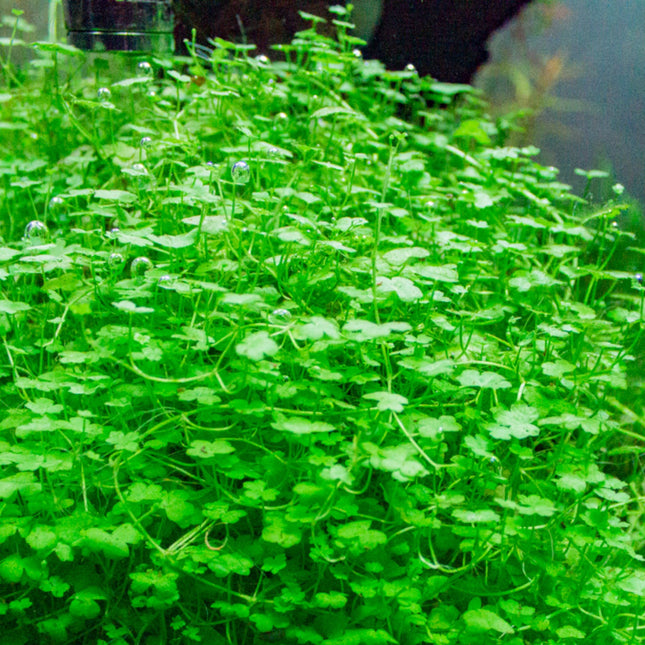
Hydrocotyle tripartita is a delicate foreground plant that can be grown in both low- and high-tech setups. It has light green clover leaves, which are particularly well suited to nano aquariums. Trim the long stems if you want this plant to remain small. Hydrocotyle Tripartita needs oxygenation for optimal growth, but it can also grow immersed or emersed--it's beautiful addition for wabi kusas with limited lighting! Under inadequate light these plants become leggy and start reaching towards the surface; trim them when they get too tall so it will maintain its desired form. NOTE: 5 stems 10cm each on each one If the quantity is zero it means we are letting the plant rest and regrow
$15.00
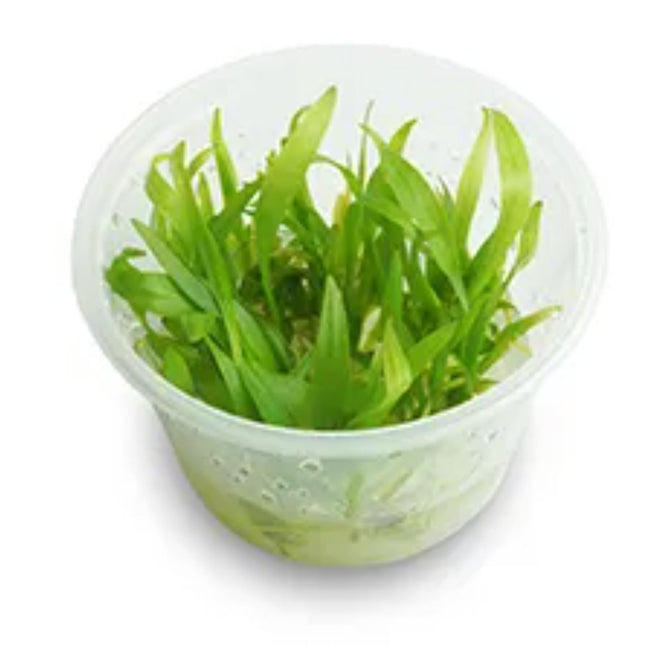
Family: AlismataceaeCommon Name: Chain SwordOrigin and Habitat: Neotropical; reported from areas in Mexico, Central America, West Indies, and South America down to northern Argentina.Ideal position in aquariumA fore-ground and mid-ground plant in large tanks, or background in smaller tanks.Lighting requirementsModerate; under brighter light the leaves will be smaller [see additional comments under Physical Description].Growth rateMediumMinimum Tank SuggestionN/AWater parameters for Chain SwordSoft to moderately hard (4 to 15 dGH), acidic to basic (pH up to 7.5), temperature 22-30C/72-86F.
$17.95
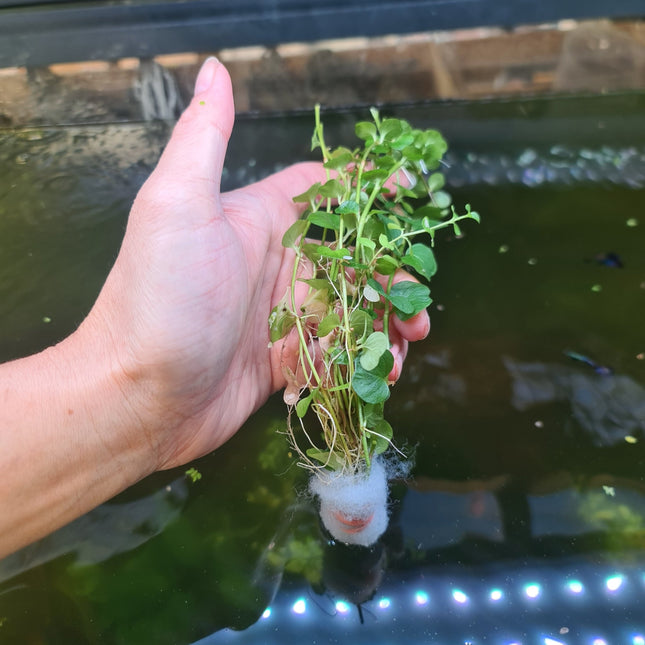
Brazilian Pennywort is a great plant for the home aquarium. It can be kept as either rooted or floating, and it will grow up toward light with its leaves shaded underneath in order to provide cover from intruders looking for safe resting spots. Brazilian Pennywort leaves offer a beautiful green colour to your tank. They're different from some other plants, like Water Sprite or Anacharis that may be more typical in an aquarium setting but are still worth keeping if you want something with interesting variety! Brazilian pennywort (Hydrocallis tr subcontracta) is quite unusual among plant life for exactly this reason: its leaf shape sets it apart visually as well as anatomically--you can tell right away just by looking at them whether they come from Brazilians or not; there's nothing else remotely similar out there anywhere nearby either inside our own country borders Aquarium pH: 6.0 – 7.8 Water Temperature: 22 – 30°C Tank Size: Any, but the plant can grow fast and take over quickly Lighting: Wide range, community tank lighting should work fine
$5.00
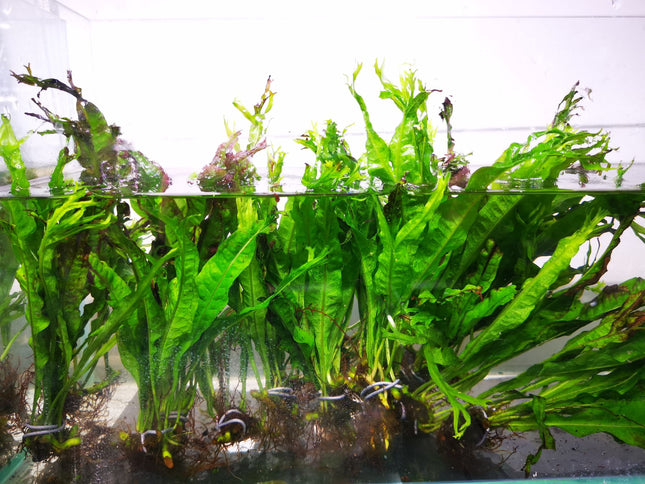
Java Fern Windelov crested is a type of aquarium plant that has a distinctive and beautiful appearance. It has a long, frilly-looking leaf with a deep green hue. The leaves can reach up to 10 inches in length and are slightly curved and wavy. The plant has a moderate to fast growth rate and requires medium to low light and a moderate to high water temperature. It is a great addition to any aquarium and is easy to care for. It is also known to be effective in reducing nitrate levels and improving water clarity.
$10.00
![[GROWN HERE IN THE STORE] Thin Vallisneria (Vallisneria Torta) - The Elegant, Easy - Growing Background Plant - Nano Tanks Australia](http://nanotanksaustralia.com.au/cdn/shop/files/grown-here-in-the-store-thin-vallisneria-vallisneria-torta-the-elegant-easy-growing-background-plant-1266051.jpg?v=1756827172&width=645)
🌿 Transform your aquarium into a serene, underwater meadow with Thin Vallisneria. This classic, fast-growing plant is the perfect solution for creating a lush, natural background that provides essential shelter for your fish while oxygenating your water. A favorite for beginners and experts alike, Vallisneria is famously low-maintenance. Simply plant it and watch it thrive, quickly spreading to fill your tank with vibrant, ribbon-like greenery. HIGHLIGHTS: Rapid Growth: Establishes quickly and spreads via runners for a full, natural look. Easy Care: Thrives in a wide range of water conditions with minimal effort. Natural Filtration: Helps absorb excess nutrients, reducing algae and improving water quality. Provides Shelter: Creates a safe haven for shy fish, shrimp, and fry. PRODUCT DETAILS: Common Name: Thin Vallisneria Scientific Name: Vallisneria Torta Origin: Southeast Asia Growth Rate: Fast Light Requirement: Low to Moderate Care Difficulty: Easy Placement: Background Propagation: Spreads by sending out runners (stolons) WHAT YOU GET: You will receive one (1) loose bunch of Thin Vallisneria, containing 5+ healthy individual stems with established roots. Please note: As a live plant, some melt may occur while it adapts to your aquarium. This is normal, and new growth will quickly follow. We want to make sure that what we sell will root well and therefore please note that the size of your plants want be that big. FAQ & PLANTING TIPS How do I plant Thin Vallisneria?Gently separate the stems. Using planting tweezers, plant each individual stem into your substrate (gravel or sand works fine), ensuring the crown (where the leaves meet the roots) is just above the substrate. Space them a few inches apart to allow runners to spread. Will it grow in my low-tech tank?Absolutely! Thin Vallisneria is an excellent choice for low-tech setups without CO2 injection. It will benefit from root tabs or liquid fertilizers but can often grow well without them. How tall does it get?It typically reaches heights of 10-20 inches, making it ideal for the mid-to-background of most aquariums. It will grow to fit the height of your tank. Why are the leaves twisted?The slightly twisted, corkscrew-like form of the leaves is a natural characteristic of the Vallisneria Torta species, giving it more texture and visual interest than straight Vallisneria varieties. 🏡 CREATE THE AQUASCAPE OF YOUR DREAMS!Pair Thin Vallisneria with driftwood, rocks, and other easy plants like Anubias or Java Fern for a stunning, natural-looking ecosystem. Your fish will thank you for the beautiful and functional home! 🔒 LIVE ARRIVAL GUARANTEED: We take extra care in packaging our plants to ensure they arrive healthy and vibrant. Please refer to our policy page for details. Add Thin Vallisneria to your cart and start your underwater garden today! Please note that pond snails and algae maybe present
$10.00
![[ALWAYS IN STOCK] Guppy Grass aka Pearlweed (Najas guadalupensis) - The Versatile Aquarium Carpet Plant - Nano Tanks Australia](http://nanotanksaustralia.com.au/cdn/shop/files/always-in-stock-guppy-grass-aka-pearlweed-najas-guadalupensis-the-versatile-aquarium-carpet-plant-5845063.jpg?v=1759763041&width=645)
The Ultimate Versatile Plant for Any Aquarium! PORTION SIZE: 5 Stems approx 10cm each. Great to start your tank in. Short Description:Discover Pearlweed - the incredibly adaptable aquarium plant that does it all! Whether you want a lush carpet, a dense bush, or floating surface cover, this fast-growing plant delivers stunning bright green results. Perfect for beginners and aquascaping pros alike. Key Features & Highlights 🌱 INCREDIBLY VERSATILE: Use as carpeting plant, bushy midground, or floating surface cover - adapts to any placement 💨 FAST GROWTH: Quickly fills in empty spaces and helps control algae by consuming excess nutrients 💪 EASY & LOW LIGHT: Thrives in low to moderate light without CO2 injection - perfect for beginner plant keepers 🦐 SHRIMP & FRY PARADISE: Dense growth provides perfect hiding spots and grazing surfaces for shrimp and baby fish ✂️ EASY PROPAGATION: Simply trim and replant stems to quickly multiply your plant collection Detailed Description Meet Pearlweed, the unsung hero of the aquarium plant world! This North American native has earned its place in aquariums worldwide thanks to its remarkable adaptability and vigorous growth. Whether you're creating your first planted tank or designing an elaborate aquascape, Pearlweed delivers stunning results with minimal effort. What makes Pearlweed truly special is its chameleon-like ability to adapt to how you plant it. When regularly trimmed, it forms a dense, bright green carpet that rivals more demanding plants. Left to grow taller, it creates beautiful bushy clumps perfect for midground placement. And when left floating, it provides valuable surface cover for shy fish and breeding tanks. This plant is particularly valuable for new aquarists, as its fast growth provides immediate satisfaction and helps establish tank balance. For experienced hobbyists, it's an essential tool for filling spaces and creating natural-looking aquascapes without the high maintenance requirements of more delicate species. Perfect For: Beginner planted tanks Carpeting experiments Shrimp and fry tanks Fast-filling new setups Low-tech aquariums Breeding tanks Specifications & Care Guide Parameter Requirement Scientific Name Najas guadalupensis Common Names Pearlweed, Guppy Grass Lighting Low to High CO2 Requirement Not Required (Benefits from supplementation) Growth Rate Very Fast Difficulty Level Easy Placement Foreground, Midground, or Floating Temperature 68°F - 82°F (20°C - 28°C) Propagation Stem cuttings Planting & Maintenance Planting Methods: Carpeting: Plant small stems close together and trim regularly Bushing: Group several stems together and allow to grow upward Floating: Simply drop stems in water - they'll naturally float and grow Maintenance: Trim weekly to maintain desired shape Replant trimmings to fill bare spots Thrives with regular liquid fertilizers Can grow 1-2 inches per week in optimal conditions Benefits: Rapidly improves water quality Provides oxygen through photosynthesis Reduces algae competition Creates natural habitat for aquatic life Important Considerations ⚠️ FAST GROWTH: Requires regular trimming to prevent overgrowth 🚫 CAN BECOME INVASIVE: Dispose of trimmings carefully, don't release into local waterways 🌿 VERSATILE BUT MESSY: Floating growth can appear unkempt if not maintained 🐠 EXCELLENT COVER: Ideal for breeding tanks and shy species 💡 ADAPTS TO LIGHT: Growth pattern changes based on light intensity 🔄 EASY TO CONTROL: Simple to remove or thin out if it grows too vigorously Healthy Plant Guarantee Our Pearlweed is grown in optimal conditions and shipped with careful packaging to ensure it arrives fresh and healthy. Each portion is pest-free and ready to plant upon arrival. Ready to transform your aquarium with this versatile plant? Add Pearlweed to your cart today!
$6.00
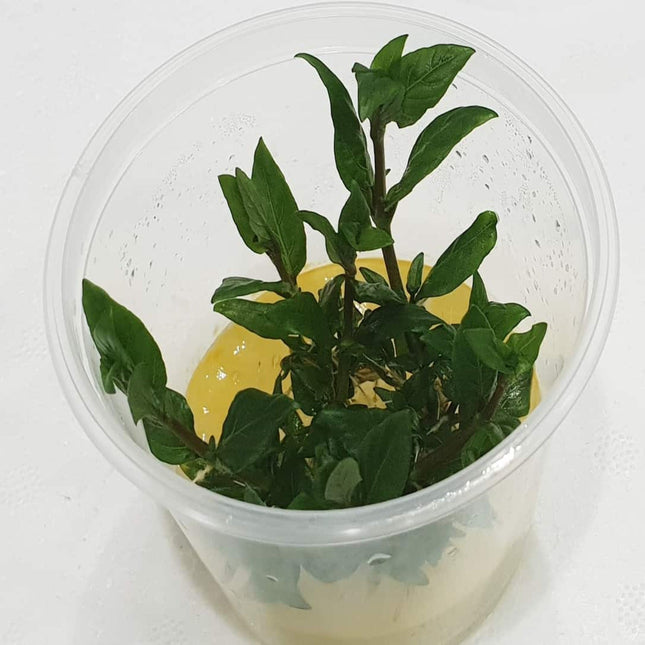
Type: Stem Origin: South America Growth rate: Medium Height: 3 - 10+cm Light demand: Low CO2 : Low
$14.95

Also known as Ceratopteris thalictroides "Fein" Fine-leaved Fast growing Not demanding Also suitable as floating plant Ceratopteris thalictroides is an amphibic fern found in many tropical regions of the world in shallow waters and on muddy ground, amongst others in rice paddies. In some tropical regions of Asia the emersed leaves of this species are used as vegetable. In nature, this plant is said to be an annual plant, however, it can be cultivated over several years without problems. The species contains many local forms, and in aquaristics, varietys with more coarsely or finely pinnate submersed leaves are common (photos 1 to 3 show an especially delicate form of C. thalictroides). The species has been known in the hobby for many years, also under the synonym of Ceratopteris siliquosa as well as under the vernacular names of water sprite, Indian fern, Oriental waterfern and water hornfern.Botanists disagree whether Ceratopteris cornuta, originating from Africa, is to be considered a species of its own or a synonym of C. thalictroides. In aquaristics, those plants with coarser lobes/leaflets are generally called C. cornuta, and those with finer leaflets are known as C. thalictroides. It is not clear, however, if those coarser-looking plants are truly C. cornuta or simply a variety of C. thalictroides (in the narrower sense). A third species, Ceratopteris richardii, can only be discerned from C. thalictroides and C. cornuta by the number of spores per sporangium. Moreover, Ceratopteris species are known to hybridise.C. thalictroides is a very fast growing fern and is usually cultivated free-floating on the water surface, like all other Ceratopteris species. Labyrinth fish gladly accept it for building their bubble nests, and it provides fish fry with great places to hide. However, when planted into the ground it grows even better as a submersed plant. C. thalictroides forms large, fine-leaved, light green bushes within a short time, and as it requires a lot of space it is best cultivated in large tanks as solitary plant. Its requirements are not difficult to meet; medium light intensities and CO2 concentrations of under 20 mg/l are sufficient, however, the fern will grow better under intensive light, with additional CO2 and nutrient-rich water.It forms plantlets in the grooves between the lobes of older leaves, like other Ceratopteris species, however, in lower numbers. In order to further the development of these plantlets it is recommended to sever the older leaves from the plant and let them float on the surface.In shallow water and on wet substrates rich in nutrients, C. thalictroides forms emersed leaves, which are finely pinnate, too. Spore-carrying fronds have very narrow leaf tips. Their margins are rolled in towards the underside and thus cover the sporangia (spore capsules). Synonyms Acrostichum thalictroides L., Ceratopteris froesii Brade, Ceratopteris gaudichaudii Brongn., Ceratopteris siliquosa (L.) Copel. Complete botanical name Ceratópteris thalictroídes (L.) Brongn. Family Pteridaceae Genus Ceratopteris Difficulty easy Usage Background, Plant for spawning, Midground, Specimen plant, Water surface Growth very fast pH value 5 - 8 Temperature tolerance 18 - 30°C Carbonate hardness 0 - 21°dKH General hardness 0 - 30°dGH Propagation Proliferating leaves, Spores Can grow emersed? yes Source: flowgrow
$10.00
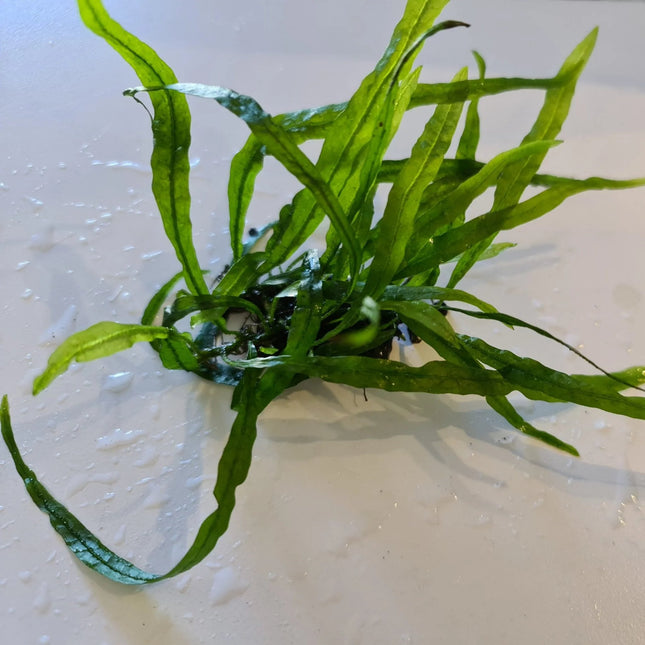
Needle-Leaf Java Fern Loose is a type of fern that is native to tropical climates, including parts of India and Southeast Asia. It features thin, needle-like leaves that are bright green in color and grow in a loose, spreading pattern. It prefers low to medium lighting conditions and is an easy-care plant, making it a great choice for beginners. It is a slow-growing plant and can be propagated by division or by removing the rhizomes and replanting them in fresh substrate. It is an ideal plant for adding texture and color to aquariums, terrariums, or vivariums.
$20.00

JAVA FERN: THE BEST PLANT FOR YOUR PLANTED AQUARIUM Java ferns (microsorum pteropus) are perfect for aquariums. They're small, easy to grow, and don't need a lot of light to survive. Ask us for varieties we have available. For example, there are needle leaf varieties that require bright lights, as well as more traditional 'jungle' leaves such as the Narrow Leaf, Lance Leaf, and Windelov – their many varieties to suit your needs inside your aquarium. Your fish will appreciate the natural hiding spots provided by Java Fern so they can get away from time to time and feel safe and secure when they want it. Identification If you want a true aquatic plant that can grow when submerged in water or even partially out, then the Java fern is perfect for your tank. Our diverse line of beautiful and delicate-looking Java plants are perfect for people who prefer an aesthetic look inside their home aqua garden without crazy maintenance requirements. When you require a go-to plant that looks great in almost any aquascapes, go with Java Ferns (from Nano Tanks Australia with our aquascaping expertise, of course!). The narrow-leaf Java fern generally boasts long, skinny leaves, with the plant growing to a height of 10-12 inches (25-30 cm). Java Fern is perfect for those who have limited space or are trying to create an artificial jungle feel in their aquarium. The plants need bright light, but indirect (not right under the light), so they can grow properly. Keep in mind the sun has a much more potent energy than your tiny aquarium lights, so aquarium keepers can tend to underestimate the wattage and spectrum required. Saying that, in nature Aquatic Java Fern tends to never receive direct light in the jungle river. So although the Java Fern will be fine with low light in the tank, its growth rate will not impress you. What You Should Know about Java Fern It's probably better than any other plant that would grow inside an aquatic environment for this reason - its fronds are big enough for fish to swim through them without getting stuck between leaves. A striking addition to any freshwater planted aquarium, perfect if you have cichlids or South American fish. Fortunately, it's also relatively easy for plant-eating goldfish and other tank mates to leave it alone because of its tough rhizomes! Java Fern does well in water with pH levels between 6-7.5, as long as the alkalinity stays below eight dKH (aka carbonate hardness). If you see black spots (or brown spots) in your plant's leaves, don't worry - they do that. Java ferns have veins running through them, and sometimes new bumps will pop up on the leaf from which a new shoot emerges. Planting and Replanting Java Fern in the Aquarium Java ferns grow beautifully with other live plants since they are so robust, but they also make a great centrepiece for the aquarium when planted alone. Alternatively, you can attach java fern to aquarium decorations (like rock or driftwood) to create an elegant look that will not overwhelm your fish tank with too much greenery! Java Fern is a hardy plant that can live in any tank size, making it perfect for apartment dwellers who don't have room for large aquariums! If the water stays clean (and you're not adding liquid fertiliser), this resilient Fern's growth will remain consistent without any problems. The Fern prefers water with soft-to-moderate temperatures of 22 degrees Celsius. Data at a glance for Java Fern Family: Polypodiaceae Care Level: Easy Growth Rate: Low to Moderate Maximum Size: 30cm Minimum Tank Size: 20 Litres (tall tank) Water Conditions: 20-28°C pH 6.0-7.5 KH 3-8 Lighting: Low to Moderate (Depending on the desired rate of growth) Propagation: Adventitious Plantlet/Rhizome Division Placement: Mid to Background
$30.00
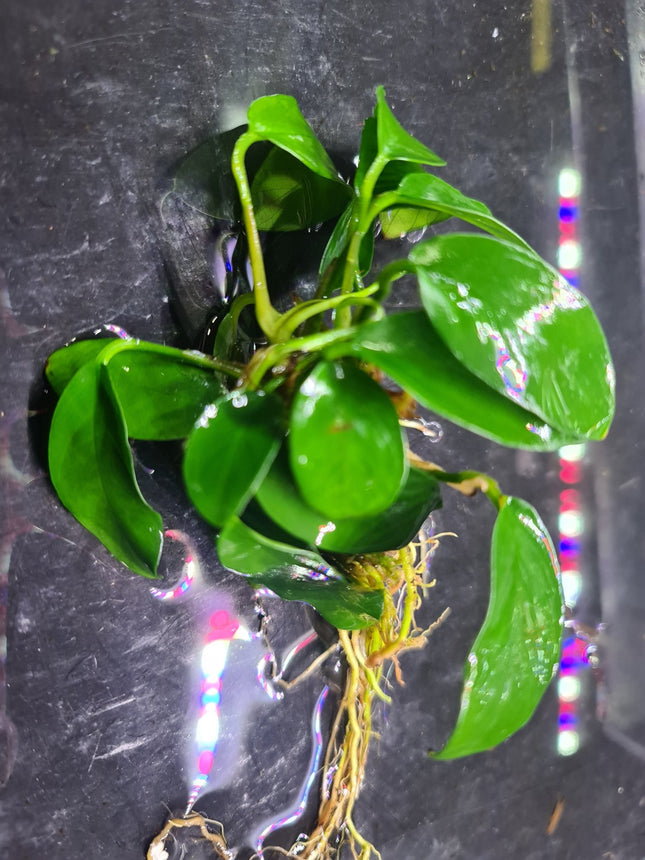
Sold as individual pieces. The image is an example of the quality you are getting Most of what is being sold are: Anubias Barteri Anubias Hastifolia Anubias Nana This is random and there is no choice on which plant you will get unless you are in the shop picking it out yourself
$25.00
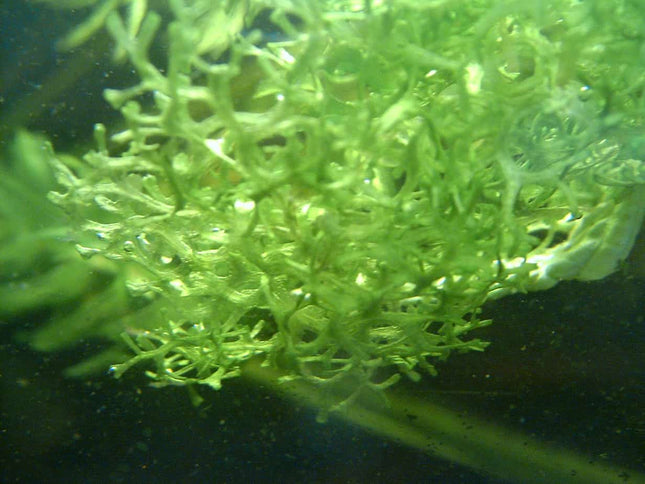
Riccia fluitans, whose common name is floating crystalwort, is an aquatic floating plant of the liverwort genus Riccia which is popular among aquarists as a retreat for young fry and is used in live-bearing tanks. It can be found floating in ponds, and often forms thick mats on and under the water surface. It normally grows quickly at the surface. When kept about two to three inches below an ordinary fluorescent bulb or in a pond exposed to full sunlight, it will form dense, bright green mats. Any single branch or antler bud can reproduce into a large colony if the plant is kept in proper conditions. It normally floats, but can also be attached to underwater objects such as logs and rocks. It can be attached with plastic mesh. Floating crystalwort is generally not compatible with duckweeds, as they cover the surface of the water quite rapidly, crowding the Riccia out. It is also easily overtaken by hair algae. Source: Wikipedia contributors. (2019, June 5). Riccia fluitans. In Wikipedia, The Free Encyclopedia. Retrieved 05:38, October 19, 2019, from https://en.wikipedia.org/w/index.php?title=Riccia_fluitans&oldid=900409775
$9.95
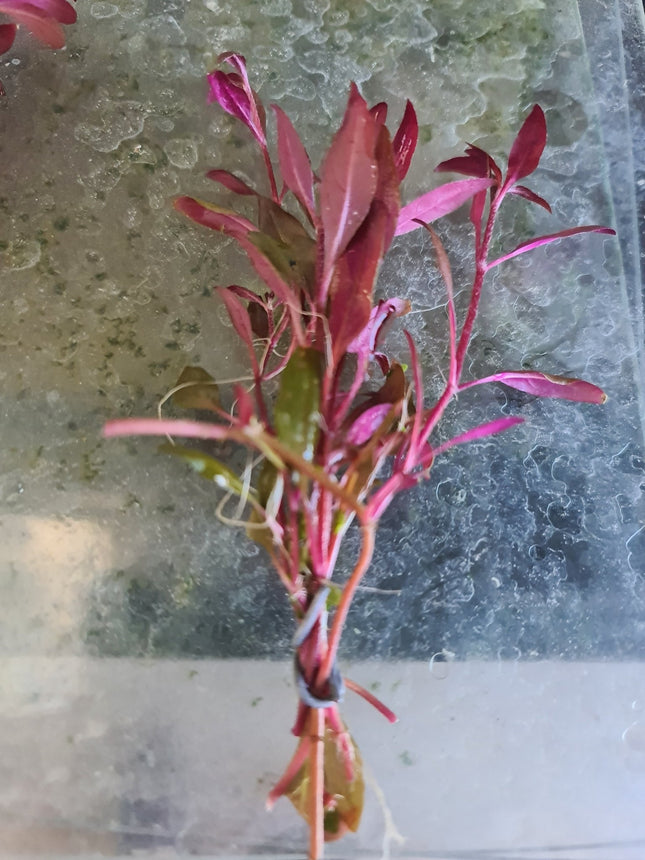
This miniature version of the well-known Alternanthera is characterised by compact growth and a slower growth rate. It is particularly suitable for small aquariums or as a foreground plant in larger aqua scapes. By careful trimming can you create a dense, red-violet carpet approximately 5 to 10 cm high. High light intensity and addition of CO2 improves the plants growth and overall appearance. Plant information Type: Stem Origin: Cultivar Growth rate: Medium Height: 5 - 10+ Light demand: Medium CO2 : Medium Reference: https://tropica.com/en/plants/plantdetails/Alternantherareineckii'Mini'(023CTC)/4439 Please note that Pisces has omitted the 'mini' label in their recent labels. However we are assured these are still the mini variety This is for 5 stems around 10cm long
$10.00
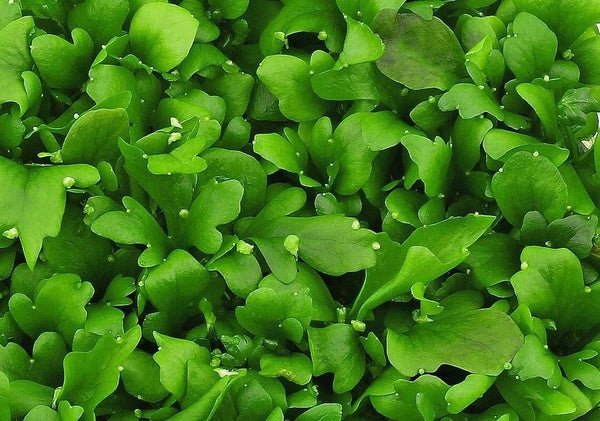
The Floating antler-fern, or Ceratopteris pteridoides, is distributed from the American subtropics and tropics from south eastern U.S. to South America and is also reported from Southeast Asia. As a floating aquarium plant, Ceratopteris pteridoides needs above all a plentiful nutrient supply and good lighting. The favourable temperatures lie between about 18 and 30 °C. Nutrient deficiency or imbalance may lead to pale new leaves and poor growth. Under favourable conditions this fern may get large within a quite short period. If the leaf rosettes have become too large for the tank, they can be replaced by some of the many young plantlets that develop on old, also detached leaves. This large, decorative water sprite species looks best in open tanks where is provides shelter for the aquarium inhabitants.
$10.00
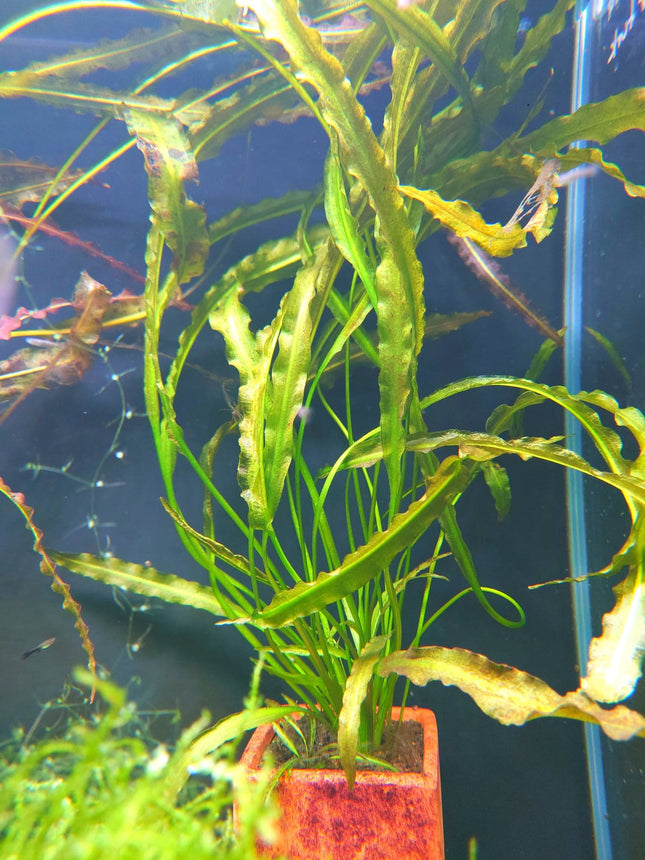
Aponogeton crispis is a small aquatic plant native to Sri Lanka and popular in aquariums. It has a rosette of stiff, crisp leaves that are light green to dark green in color. The leaves grow to a maximum size of around 6 inches in length and 3 inches in width. Its flower stalk grows to a height of about 10 inches, bearing small white flowers. Aponogeton crispis is a low maintenance plant that does not require extra fertilization or supplemental lighting in order to thrive. It is a great choice for an aquarium as it will not take up too much space and is relatively hardy.
$20.00
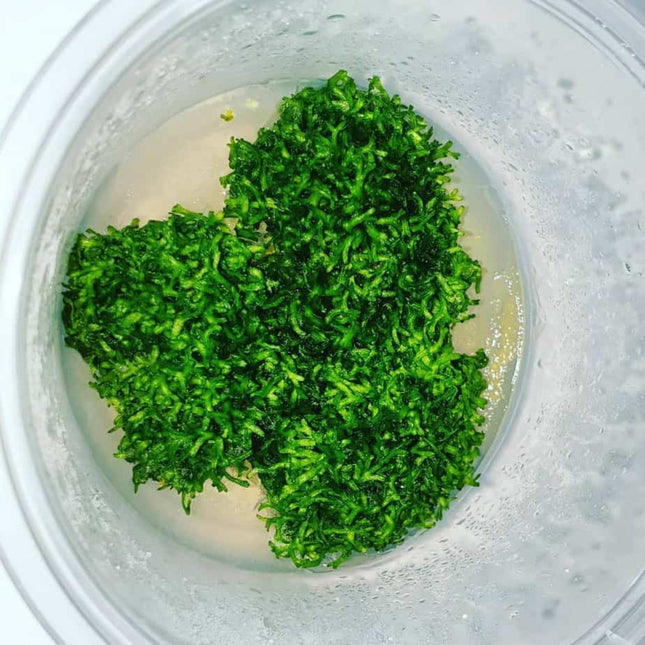
Riccia fluitans, whose common name is floating crystalwort,[1] is an aquatic floating plant of the liverwort genus Riccia which is popular among aquarists as a retreat for young fry and is used in live-bearing tanks. It can be found floating in ponds, and often forms thick mats on and under the water surface. It normally grows quickly at the surface. When kept about two to three inches below an ordinary fluorescent bulb or in a pond exposed to full sunlight, it will form dense, bright green mats. Any single branch or antler bud can reproduce into a large colony if the plant is kept in proper conditions. It normally floats, but can also be attached to underwater objects such as logs and rocks. It can be attached with plastic mesh. Floating riccia is generally not compatible with duckweeds, as they cover the surface of the water quite rapidly, crowding the Riccia out. It is also easily overtaken by hair algae. The species epithet fluitans is Latin for floating. Referene:https://en.wikipedia.org/wiki/Riccia_fluitans
$14.95
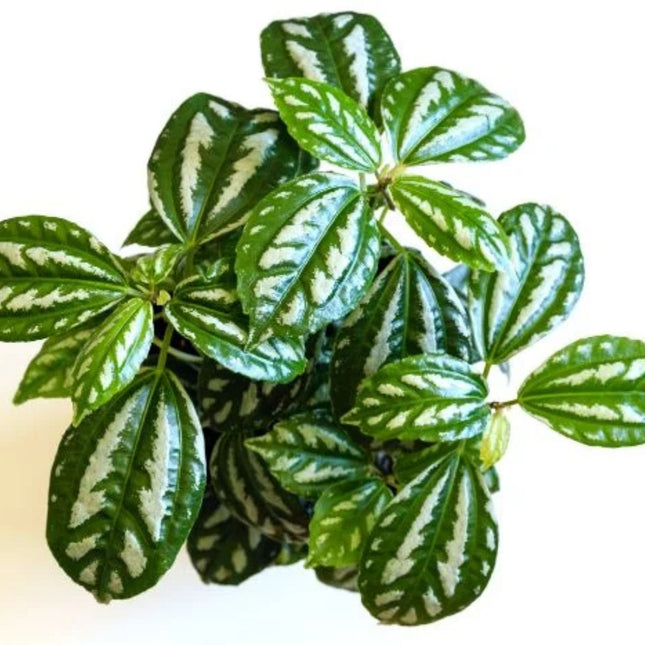
Aluminum plants are a type of flowering shrub that is native to tropical and subtropical regions of the world. They are evergreen shrubs that grow up to six feet tall, with a dense, upright growth habit. The leaves are glossy green, oval-shaped, and have toothed edges. The flowers are small and yellowish-white. Aluminum plants produce small, orange-red berries. These plants are easy to care for, and can tolerate low-light conditions. They make excellent houseplants and are often used in containers. These plants are great for terrarium tanks
$8.00
You have seen 36 out of 121 products